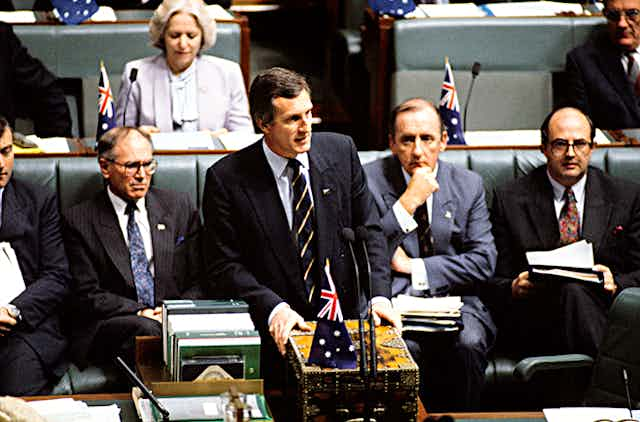The 1992-93 cabinet papers, released today by the National Archives of Australia, reveal a government struggling for solutions to myriad problems.
These were tough, lean years for Australia. The recession “we had to have” was still biting deeply into the economy and showed no signs of lifting. The rural drought was still in full sway. Business confidence was shot.
The Labor government was entering its fourth term in government, unsure of its direction and suffering a crisis of confidence. It appeared besieged on all fronts, not least as the John Hewson led Opposition released Fightback! in 1991 – a neoliberal plan advocating major social and economic change.
Initially blindsided by the Opposition’s agenda, Labor gambled by changing its leader for the first time while holding office. Frustrated at the economic meltdown that had greeted his pro-market policies, new Prime Minister Paul Keating was uncertain as to the best steps to take going forward. He did not want to reverse his reform legacy, but was searching for solutions.
But newly released cabinet papers show that while the Labor government was trying to reassure itself that it was “not weakening our resolve”, many ministers were clearly reform fatigued.
To fill this void, much policy work was going on behind the scenes, largely led by a small number of key public officials, central agency bureaucrats and tireless taskforce working groups. The minions were busy crafting an omnibus agenda for a government that had tired itself out.
The issues
The Keating government was preoccupied with two big issues in 1992. First, a surging unemployment rate, and especially the increasing number of long-term unemployed workers who were virtually unemployable. Second, a budget deficit then hovering at around A$5.5 billion and getting slightly worse by the month.
Unemployment was 10.6% in December 1991 and expected to grow to 11% by 1992 before falling slowly thereafter. Government spending was still growing by 4% per annum and had increased Commonwealth outlays to 26.2% of GDP, while revenues were weak but slowly trending upwards. These twin problems overshadowed almost all the government contemplated and did. Cabinet briefs, with anything up to six or seven listed options to “do something”, were invariably about setting out the lowest cost option in the longer-term.
Scrambling for solutions
In the first few months of 1992 the Keating government busied itself pulling together its major economic statement named the One Nation statement. It built on a series of other economic and employment packages, from Building a Competitive Australia (1991) through to Working Nation (1994)).
The wonderfully named “Ad Hoc Committee of Cabinet”, seemed to be making the lion’s share of the key decisions. Senior ministers on the ad hoc committee were able to indicate pending decisions even before portfolio ministers had been consulted or agreed them, or cabinet had formally endorsed such decisions.
The statement reflected the frenetic policy process across government that had driven its construction. It was called a “stocktake of the government’s achievements” and reaffirmation of the “further pursuit of microeconomic reform”. Even items earmarked for release separately (such as the science and technology measures) were folded into the economic statement to maximise its breadth and intended impact.
The nation-building package became a grab bag of initiatives, most of which were only loosely related to the main themes. It included tax cuts, science and technology measures, R&D concessions, transport and electricity shakeups (Trans-Tasman shipping), mobile and radio frequency spectrums, postal services, housing needs, regulatory relaxations, selective privatisation of government business enterprises, the establishment of a new national rail corporation, infrastructure projects especially road network improvements, heritage and environmental projects, support for union amalgamations, drought relief, urban projects and city planning, various submissions called “further proposals”, and even funding for the newly announced second Sydney airport at Badgery’s Creek!
Much of this activity was rebadging existing programs or tweaking them to imply the government was doing something.
Various assistance packages were announced but most were short term adjustment programs. Not many amounted to much in terms of dollar amounts. There was a more general interest in labour market programs, with some continual renaming of employment creation schemes as the targeted cohort changed or proved difficult to place in jobs. Job scheme programs called Jobtrain were replaced by Jobstart and Jobskills, and others were invented to target those that did not fit the eligibility criteria such as the self-employed adjustment program or SEAP.
Moving forward
The government would later go onto other agendas in 1992 and 1993 (social, cultural, industrial relations, regional, Indigenous, refugees, disabilities, aged care etc.) once it had released its major economic paper. But the difficult years of 1992-93 show that while the main agendas of the government’s daily business sheet remained economic matters, grand politics began to triumph over the dismally-inclined economic agendas.
The One Nation economic statement did not itself turn around the economic malaise or improve the immediate political standing of the government, but it did provide a circuit-breaker to allow Paul Keating to boast he still had economic credentials while he dismantled “more slowly” John Hewson’s Fightback! strategy over the remaining months of 1992-93.

